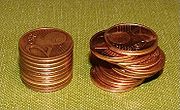
Cavalieri's principle
Encyclopedia

Geometry
Geometry arose as the field of knowledge dealing with spatial relationships. Geometry was one of the two fields of pre-modern mathematics, the other being the study of numbers ....
, Cavalieri's principle, sometimes called the method of indivisibles, named after Bonaventura Cavalieri
Bonaventura Cavalieri
Bonaventura Francesco Cavalieri was an Italian mathematician. He is known for his work on the problems of optics and motion, work on the precursors of infinitesimal calculus, and the introduction of logarithms to Italy...
, is as follows:
- 2-dimensional case: Suppose two regions in a plane are included between two parallel lines in that plane. If every line parallel to these two lines intersects both regions in line segments of equal length, then the two regions have equal areas.
- 3-dimensional case: Suppose two regions in three-space (solids) are included between two parallel planes. If every plane parallel to these two planes intersects both regions in cross-sectionsCross section (geometry)In geometry, a cross-section is the intersection of a figure in 2-dimensional space with a line, or of a body in 3-dimensional space with a plane, etc...
of equal area, then the two regions have equal volumes.
Today Cavalieri's principle is seen as an early step towards integral calculus, and while it is used in some forms, such as its generalization in Fubini's theorem
Fubini's theorem
In mathematical analysis Fubini's theorem, named after Guido Fubini, is a result which gives conditions under which it is possible to compute a double integral using iterated integrals. As a consequence it allows the order of integration to be changed in iterated integrals.-Theorem...
, results using Cavalieri's principle can often be shown more directly via integration. In the other direction, Cavalieri's principle grew out of the ancient Greek method of exhaustion
Method of exhaustion
The method of exhaustion is a method of finding the area of a shape by inscribing inside it a sequence of polygons whose areas converge to the area of the containing shape. If the sequence is correctly constructed, the difference in area between the n-th polygon and the containing shape will...
, which used limits but did not use infinitesimals.
History
The transition from Cavalieri's indivisibles to John Wallis's infinitesimalInfinitesimal
Infinitesimals have been used to express the idea of objects so small that there is no way to see them or to measure them. The word infinitesimal comes from a 17th century Modern Latin coinage infinitesimus, which originally referred to the "infinite-th" item in a series.In common speech, an...
s was a major advance in the history of the calculus. The indivisibles were entities of codimension 1, so that a plane figure was thought as made out of an infinity of 1-dimensional lines. Meanwhile, infinitesimals were entities of the same dimension as the figure they make up; thus, a plane figure would be made out of "parallelograms" of infinitesimal width. Applying the formula for the sum of an arithmetic progression, Wallis computed the area of a triangle by partitioning it into infinitesimal parallelograms of width
 .
.Spheres

Cone (geometry)
A cone is an n-dimensional geometric shape that tapers smoothly from a base to a point called the apex or vertex. Formally, it is the solid figure formed by the locus of all straight line segments that join the apex to the base...
is 1/3 base × height, then one can use Cavalieri's principle to derive the fact that the volume of a sphere
Sphere
A sphere is a perfectly round geometrical object in three-dimensional space, such as the shape of a round ball. Like a circle in two dimensions, a perfect sphere is completely symmetrical around its center, with all points on the surface lying the same distance r from the center point...
is 4/3 × π × r 3, where r is the radius.
That is done as follows: Consider a sphere of radius r and a cylinder of radius r and height r. Within the cylinder is the cone whose apex is at the center of the sphere and whose base is the base of the cylinder. By the Pythagorean theorem
Pythagorean theorem
In mathematics, the Pythagorean theorem or Pythagoras' theorem is a relation in Euclidean geometry among the three sides of a right triangle...
, the plane located y units above the "equator" intersects the sphere in a circle of area π(r 2 − y 2). The area of the plane's intersection with the part of the cylinder that is outside of the cone is also π(r2 − y2). The aforementioned volume of the cone is 1/3 of the volume of the cylinder, thus the volume outside of the cone is 2/3 the volume of the cylinder. Therefore the volume of the upper half of the sphere is 2/3 of the volume of the cylinder. The volume of the cylinder is
- base × height = πr 2 · r = πr 3.
("Base" is in units of area; "height" is in units of distance. Area × distance = volume.)
Therefore the volume of the upper half-sphere is (2/3)πr 3 and that of the whole sphere is (4/3)πr 3.
Cones and pyramids
The fact that the volume of any pyramid, regardless of the shape of the base, whether circular as in the case of a cone, or square as in the case of the Egyptian pyramids, or any other shape, is (1/3) × base × height, can be established by Cavalieri's principle if one knows only that it is true in one case. One may initially establish it in a single case by partitioning the interior of a triangular prism into three pyramidal components of equal volumes. One may show the equality of those three volumes by means of Cavalieri's principle.In fact, Cavalieri's principle or similar infinitesimal argument is necessary to compute the volume of cones and even pyramids, which is essentially the content of Hilbert's third problem
Hilbert's third problem
The third on Hilbert's list of mathematical problems, presented in 1900, is the easiest one. The problem is related to the following question: given any two polyhedra of equal volume, is it always possible to cut the first into finitely many polyhedral pieces which can be reassembled to yield the...
– polyhedral pyramids and cones cannot be cut and rearranged into a standard shape, and instead must be compared by infinite (infinitesimal) means. The ancient Greeks used various precursor techniques such as Archimedes's mechanical arguments or method of exhaustion
Method of exhaustion
The method of exhaustion is a method of finding the area of a shape by inscribing inside it a sequence of polygons whose areas converge to the area of the containing shape. If the sequence is correctly constructed, the difference in area between the n-th polygon and the containing shape will...
to compute these volumes.
The napkin ring problem

Napkin ring problem
In geometry, it is somewhat surprising that the volume of a band of specified height around a sphere—the part that remains after a hole in the shape of a circular cylinder is drilled through the sphere—does not depend on the sphere's radius....
, one shows by Cavalieri's principle that when a hole of length h is drilled straight through the center of a sphere, the volume of the remaining material surprisingly does not depend on the size of the sphere. The cross-section of the remaining ring is a plane annulus, whose area is the difference between the areas of two circles. By the Pythagorean theorem, the area of one of the two circles is π times r 2 − y 2, where r is the sphere's radius and y is the distance from the plane of the equator to the cutting plane, and that of the other is π times r 2 − (h/2) 2. When these are subtracted, the r 2 cancels; hence the lack of dependence of the bottom-line answer upon r.
Cycloids

Cycloid
A cycloid is the curve traced by a point on the rim of a circular wheel as the wheel rolls along a straight line.It is an example of a roulette, a curve generated by a curve rolling on another curve....
by using Cavalieri's principle. A circle of radius r can roll in a clockwise direction upon a line below it, or in a counterclockwise direction upon a line above it. A point on the circle thereby traces out two cycloids. When the circle has rolled any particular distance, the angle through which it would have turned clockwise and that through which it would have turned counterclockwise are the same. The two points tracing the cycloids are therefore at equal heights. The line through them is therefore horizontal (i.e. parallel to the two lines on which the circle rolls). Consequently each horizontal cross-section of the circle has the same length as the corresponding horizontal cross-section of the region bounded by the two arcs of cyloids. By Cavalieri's principle, the circle therefore has the same area as that region. (It is a short step from there to the conclusion that the area under a single whole cycloidal arch is three times the area of the circle.)
External links
- Prinzip von Cavalieri (in German)

